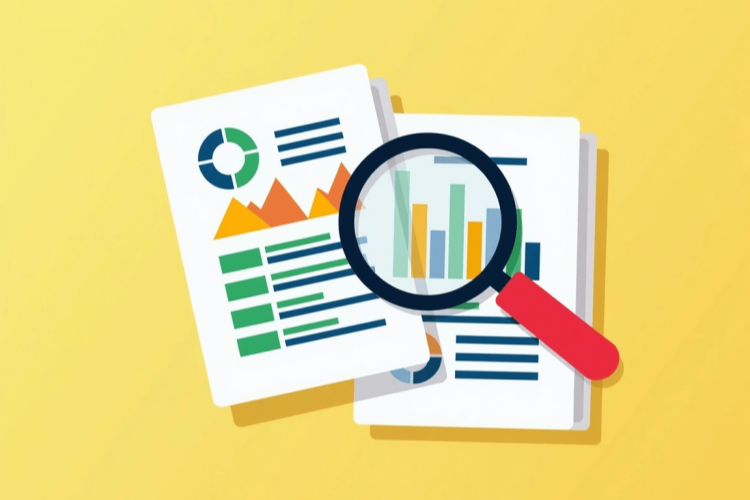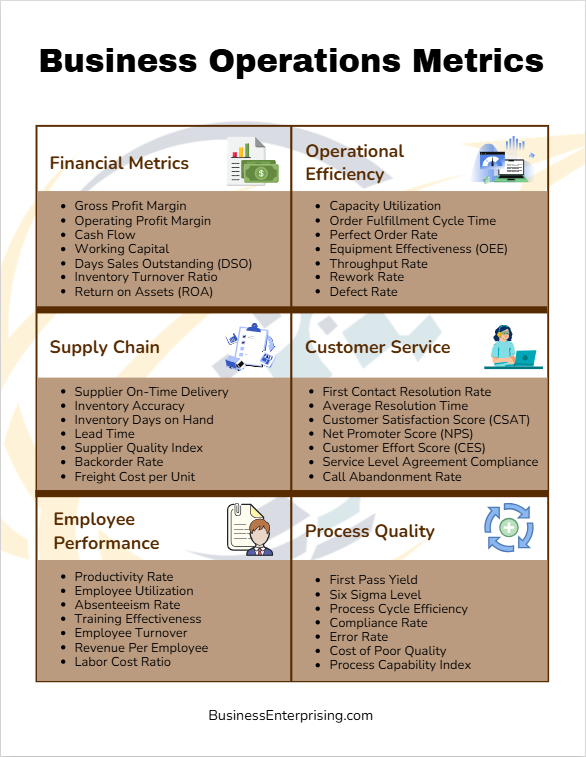 Running a business requires more than offering great products or services. You must understand how well your operations perform daily. Therefore, tracking the right metrics for business operations is essential to keep your business productive and profitable. These metrics help you evaluate how efficiently your resources, people, and systems work together.
Running a business requires more than offering great products or services. You must understand how well your operations perform daily. Therefore, tracking the right metrics for business operations is essential to keep your business productive and profitable. These metrics help you evaluate how efficiently your resources, people, and systems work together.
Additionally, operational metrics allow you to spot issues early and make informed decisions. However, not all metrics offer the same value to your business. Some metrics may seem useful but fail to reflect meaningful results. Therefore, selecting the right metrics gives you better visibility into your company’s performance.
Furthermore, understanding operational metrics helps you identify waste, delays, or inefficiencies. You can then take action to improve workflows and outcomes. Additionally, by measuring these areas consistently, you can track progress and adjust your strategies when needed. This prevents small issues from growing into serious problems.
However, many business owners struggle to choose the right data points to monitor. Too much information often leads to confusion rather than clarity. Therefore, it’s important to focus on a few key metrics aligned with your business goals. This allows you to spend less time analyzing and more time improving operations.
By tracking specific, actionable metrics, you will gain real-time insights into how your business performs. Additionally, using the right tools makes it easier to measure, analyze, and improve efficiency. Ultimately, operational metrics provide the information you need to run a smarter, more profitable business.
What Are Business Operations Metrics and Why Do They Matter?
Business operations metrics are quantifiable measures that assess various aspects of your company’s performance. They provide insights into efficiency, productivity, and profitability across different departments. By tracking these metrics, you gain a clear understanding of how well your business functions.
Monitoring these metrics allows you to identify areas needing improvement. For example, analyzing production cycle times can highlight inefficiencies in your manufacturing process. Addressing these issues can lead to smoother operations and cost reductions.
Additionally, these metrics help you make informed decisions. Understanding customer satisfaction scores, for instance, guides you in enhancing service quality. This can result in increased customer loyalty and repeat business.
Financial metrics, such as operating margin, reveal the profitability of your core operations. Tracking these figures enables you to adjust strategies to improve financial health.
Incorporating metrics for business operations into your management practices ensures that your company remains agile and competitive. Regularly reviewing these metrics keeps you aligned with your business goals and responsive to market changes.
Key Categories of Operational Metrics
Understanding the key categories of operational metrics is essential for evaluating and enhancing your company’s performance. These metrics offer insights into various aspects of your operations, enabling informed decision-making and strategic planning.
Productivity Metrics
Productivity metrics assess how effectively your resources are utilized. For example, measuring the number of units produced per hour helps identify areas where processes can be streamlined. By monitoring these metrics, you can pinpoint inefficiencies and implement improvements to boost output.
Financial Metrics
Financial metrics provide a snapshot of your company’s economic health. Tracking figures like operating margin and cash flow reveals profitability and cost management effectiveness. Regular analysis of these metrics for business operations aids in making sound financial decisions and ensuring long-term sustainability.
Quality Metrics
Quality metrics focus on the standard of your products or services. Monitoring defect rates or customer complaints highlights areas needing attention. Addressing these issues enhances product reliability and customer satisfaction, which are critical for maintaining a competitive edge.
Customer Metrics
Customer metrics gauge the strength of your client relationships. Evaluating customer retention rates and satisfaction scores offers insights into loyalty and service effectiveness. By understanding these metrics, you can develop strategies to improve customer experience and foster long-term relationships.
By focusing on these categories, you gain a comprehensive view of your organization’s performance. This holistic approach enables you to identify strengths, address weaknesses, and drive overall operational excellence.
Top Operational Metrics Every Business Should Track
Tracking the right operational metrics is essential for understanding and improving your business’s performance. By focusing on key indicators, you can make informed decisions and drive growth.
Inventory Turnover
One important metric to monitor is Inventory Turnover. This measures how often your inventory is sold and replaced over a specific period. A higher turnover rate suggests efficient inventory management and strong sales. Conversely, a low rate may indicate overstocking or weak demand.
Order Fulfillment Time
Another critical metric is Order Fulfillment Time, which tracks the duration from when a customer places an order to when they receive it. Reducing this time enhances customer satisfaction and can lead to repeat business. Analyzing this metric helps identify delays in your supply chain or internal processes.
Operating Margin
Operating Margin is also vital, as it reflects the percentage of revenue remaining after covering operating expenses. A healthy operating margin indicates efficient cost management and profitability. Monitoring this metric allows you to assess the effectiveness of your pricing strategies and operational efficiency.
Employee Utilization Rate
Additionally, consider tracking the Employee Utilization Rate. This measures the proportion of employees’ available time spent on productive, billable work. A high utilization rate suggests optimal use of human resources, while a low rate may reveal underutilization or inefficiencies.
By regularly analyzing these metrics for business operations, you gain valuable insights into various aspects of your company. This enables you to identify areas for improvement, optimize processes, and ultimately enhance overall performance.
How to Measure and Analyze Operational Performance
Measuring and analyzing operational performance is essential for understanding how effectively your business achieves its objectives. By systematically collecting and evaluating data, you can make informed decisions to enhance efficiency and profitability.
To begin, identify the key performance indicators (KPIs) that align with your business goals. These metrics for business operations might include production rates, customer satisfaction scores, or financial ratios. Selecting relevant KPIs ensures that your analysis focuses on areas that directly impact performance.
Next, gather accurate and timely data for each chosen metric. Utilize tools such as enterprise resource planning (ERP) systems or customer relationship management (CRM) software to collect information efficiently. Reliable data forms the foundation for meaningful analysis.
Once data is collected, analyze it to identify trends, patterns, and areas needing improvement. For instance, if you notice a decline in production efficiency, investigate potential causes like equipment malfunctions or workflow bottlenecks. Addressing these issues promptly can prevent further performance degradation.
Regularly reviewing and interpreting your operational data enables you to make proactive adjustments. By continuously monitoring these metrics, you can respond swiftly to challenges and capitalize on opportunities, fostering a culture of continuous improvement within your organization.
Using Metrics to Identify Bottlenecks and Improve Efficiency
Identifying bottlenecks is essential for enhancing your business’s efficiency. By analyzing metrics for business operations, you can pinpoint areas where workflows slow down. This insight allows you to implement targeted improvements.
For example, tracking cycle time reveals how long tasks take from start to finish. If certain processes consistently exceed expected durations, they may indicate bottlenecks. Addressing these can streamline operations and reduce delays.
Additionally, monitoring throughput helps you understand the rate at which products or services are delivered. A sudden decrease might signal obstructions in your workflow. By identifying and resolving these issues, you can maintain steady production levels.
Furthermore, analyzing resource utilization rates sheds light on how effectively your assets are employed. Underutilized resources may point to inefficiencies or misallocations. Optimizing their use can enhance overall performance.
Regularly reviewing these metrics enables you to detect and address inefficiencies promptly. This proactive approach fosters continuous improvement and supports your business’s growth objectives.
Tools and Dashboards to Monitor Business Operations Metrics
Monitoring your business’s performance effectively requires the right tools to track and visualize key metrics. Various software solutions can help you manage these metrics for business operations in real time, providing insights that drive informed decisions.
One option is Scoro, a comprehensive dashboard software that consolidates various performance indicators into a single, real-time view. It integrates with other tools, offering customizable dashboards and features for work management, financial tracking, project planning, and reporting. This integration allows you to oversee multiple aspects of your operations seamlessly.
Another tool to consider is Geckoboard, designed for small to medium-sized businesses aiming to build and share real-time KPI dashboards without requiring data specialists. It enables quick creation of dashboards that display live data from various sources, enhancing team performance through improved visibility.
For those seeking a free solution, Google Analytics offers robust capabilities for monitoring website performance. It provides insights into user behavior, e-commerce tracking, and SEO optimization, helping you understand and improve your online presence.
Additionally, Smartsheet is a cloud-based platform that combines the familiarity of spreadsheets with powerful project management features. It offers real-time dashboards, automated workflows, and integrations with various applications, facilitating efficient tracking and collaboration across projects.
Selecting the appropriate tool depends on your business’s specific needs and the complexity of the data you wish to monitor. Evaluating these options can help you find a solution that enhances your ability to track, visualize, and manage key performance indicators effectively.
Conclusion
Tracking and analyzing metrics for business operations is one of the smartest ways to improve your company’s performance. These metrics give you measurable data that reflects the efficiency, quality, and financial health of your operations. Therefore, by monitoring them consistently, you can make better decisions and spot areas that need improvement.
Additionally, using operational metrics helps you identify bottlenecks that may slow down your workflows. You can then take clear, data-driven steps to fix those issues. However, to achieve real results, you must select the right metrics for your business goals. Focusing on the wrong data will waste time and resources without adding value.
Therefore, make sure you use reliable tools and dashboards that provide real-time insights. This allows you to react quickly to problems and also adapt to changing conditions. Additionally, these tools help you visualize performance trends and make adjustments before small issues become larger problems.
However, metrics alone will not improve your business. You and your team must regularly review the data and take meaningful action. Additionally, sharing operational performance insights with your team creates accountability and encourages continuous improvement. When everyone understands how their work impacts these metrics, efficiency improves.
Ultimately, effective use of metrics for business operations creates long-term benefits. You can improve customer satisfaction, increase profitability, as well as streamline day-to-day processes. Therefore, make metrics part of your business strategy and decision-making process. By doing so, you will strengthen your business and achieve better operational outcomes.



